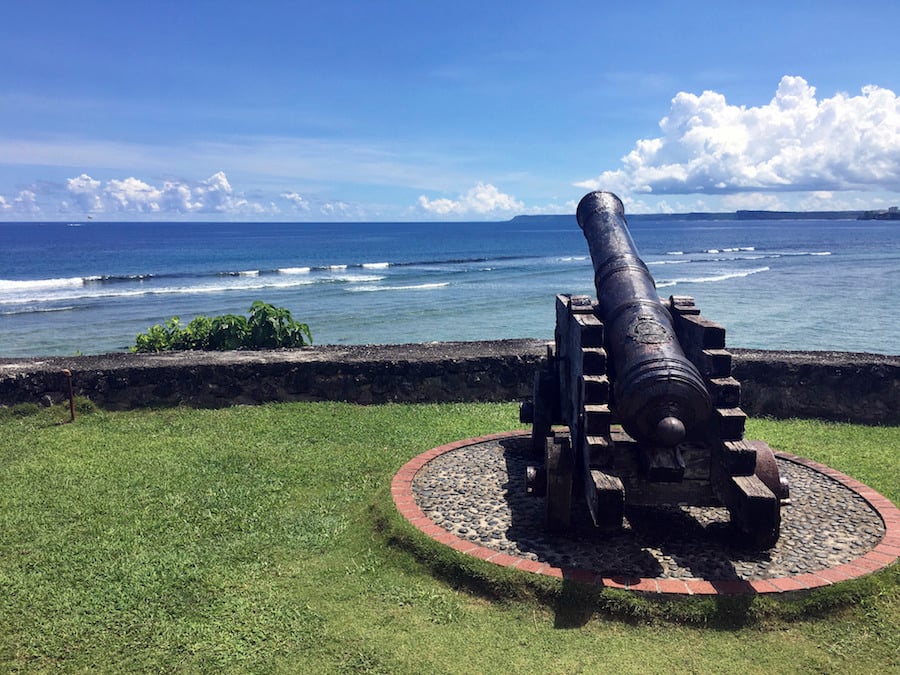(CN) — A Ninth Circuit panel on Friday affirmed a federal judge’s finding that the U.S. Navy and the Department of Defense properly assessed the environmental impact of a plan to move thousands of troops from Okinawa, Japan to the U.S. territory of Guam.
As part of U.S. military treaty obligations under the U.S.-Japan Alliance Agreement, 8,000 U.S. Marines and their families are slated to be relocated north from Okinawa and train on the Northern Mariana Islands, of which Guam is a part.
The plan — backed by a $6 billion pledge from Japan — brings ship-to-shore naval bombardment, artillery shelling, amphibious assault drills and maneuvering by attack helicopters and warplanes on Tinian and Pagan islands in connection with the military buildup on Guam.
Northern Mariana Islands conservation groups sued in federal court in 2016, claiming Pentagon officials violated the National Environmental Policy Act (NEPA) by skirting mandated environmental reviews and touting national security interests to justify rushed implementation of the plan.
Tinian Island Women Association, Guardians of Gani, Paganwatch and the Center for Biological Diversity accused the U.S. military failed to consider other locations beyond Guam and the Marianas.
Plaintiffs claimed military leaders neglected to issue a single environmental review statement that examined the “connected actions” of the full plan, including the impact of constructing new training areas for troops.
The Navy acknowledged in its 2010 and 2015 environmental impact statements (EIS) construction and operation of training facilities on Tinian and Pagan would kill or seriously damage native wildlife including endangered Mariana fruit bats as well as coral reefs.
The military branch also promised to assess the cumulative impacts of constructing training areas and ranges on the islands by deferring to a future impact statement.
U.S. District Judge Ramona V. Manglona granted summary judgment in favor of the Navy on plaintiffs’ procedural claim under NEPA and said the claim that the Navy failed to consider alternatives was a political question the court has no authority to resolve.
A three-judge Ninth Circuit panel on Friday affirmed Manglona’s ruling, finding the Navy’s troop relocation and training area construction are not “connected” actions for the purposes of an environmental impact statement.
“NEPA does not require an agency to treat actions as connected if they have independent utility and purpose,” U.S. Circuit Judge M. Margaret McKeown, a Bill Clinton appointee, wrote for the panel. “Although the two actions have overlapping goals — Marines on Guam will certainly take advantage of the training ranges and facilities in the CNMI — they also have independent utility.”
Earthjustice attorney David Henkin, who represents plaintiffs, did not immediately respond to a request for comment.
The panel rejected the plaintiffs’ assertion that allowing the Navy to defer to a future impact statement was an error.
“We have consistently held that agencies can consider the cumulative impacts of actions in a subsequent EIS when the agency has made clear it intends to comply with those requirements and the court can ensure such compliance,” McKeown wrote.
Judge Manglona’s dismissal of the complaint for lack of jurisdiction on plaintiffs’ alternative location claims was also affirmed by the panel on the basis of standing.
The panel declined to review the claim under the political question doctrine, writing that although NEPA requires a comprehensive review of alternative locations, it won’t order the Navy to modify or cancel its treaty with Japan.
“Regardless of the Navy’s analysis of alternate stationing locations for the Marines, it cannot upend that agreement,” McKeown wrote for the panel.
Attorneys for the Navy and the Department of Defense did not respond to emailed requests for comment by press time.
U.S. Circuit Judges Andrew D. Hurwitz, a Barack Obama appointee, and Bridget S. Bade, a Donald Trump appointee, rounded out the panel.
The United States invaded the Mariana Islands in 1944 and fought Japanese forces in Saipan and Guam. The Enola Gay took off from Tinian in 1945 with the atomic bomb that was dropped on Hiroshima.
The Northern Mariana Islands were administered by the United States after World War II following a United Nations Security Council resolution. They became a commonwealth of the United States in 1975.
Guam, the southernmost island in the archipelago, is a separate U.S. territory.
Subscribe to Closing Arguments
Sign up for new weekly newsletter Closing Arguments to get the latest about ongoing trials, major litigation and hot cases and rulings in courthouses around the U.S. and the world.









